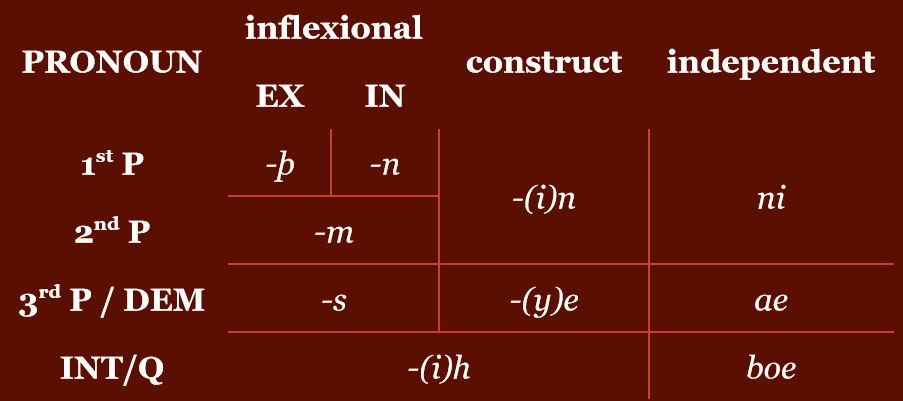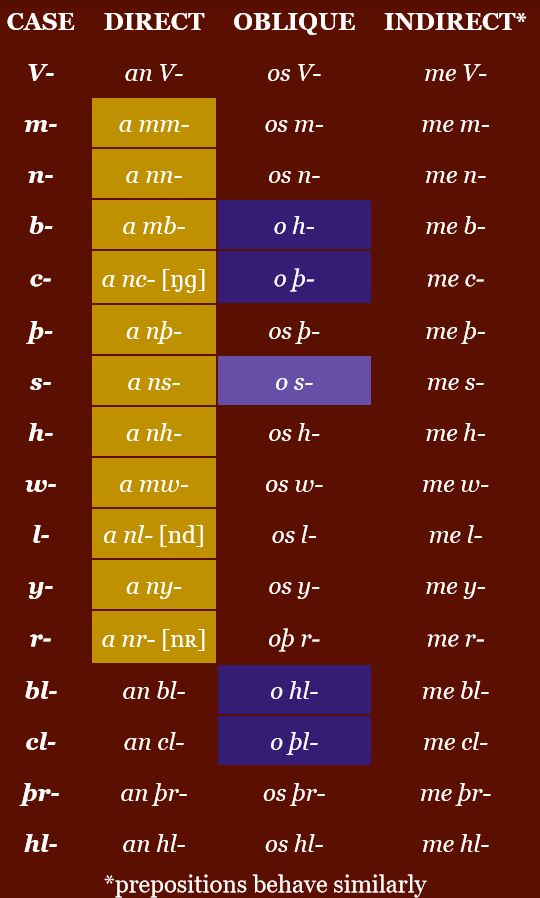claþrom
claþrom is a language i made to create a unique aesþetic· explore symmetrical voice & optional polypersonal agreement· & to translate poetry
contents
phonology & orþography
below are þe phonemes of claþrom
consonants
| labial | dental | alveolar | dorsal/glottal | |
|---|---|---|---|---|
| nasal | m | n | ||
| stop | b | k | ||
| fricative | w | θ | s | h |
| approximant | l | j | ||
| trill | r | |||
vowels
| front | back | |
|---|---|---|
| close | ɪ | o |
| open | ɛ | ɑ |
| diphthongs | ɑɛ ɛo oɛ | |
phonotactics
þe allowable onsets for a word include:
- any single consonant
- any stop followed by /l/
- þe fricative /θ/ or /h/ followed by /l/
- (nouns in þe direct case) a homorganic nasal followed by one of þe above permissible onsets
allowable nuclei are any vowel or diphthong· þe allowable codas are any nasal or fricative·
stress is on þe first syllable of þe lexical root
phonological processes
- /nk/ → [ŋg]
- /h/ → [x] at þe end of a word
- /r/ → [ʀ] (uvular trill) after /n/
- /kl/ & /hl/ → [tɬ] & [ɬˑ] respectively
- /θ/ & /s/ → [ð] & [z] respectively when between a vowel & anoþer vowel or a liquid (/l/ or /r/)
- word-initial /nl/ → [nd]
- vowels lengþen in open stressed syllables
- /b/ is devoiced → [p] after a voiceless fricative (/θ/ or /s/ or /h/
orþography
þe following consonant phonemes (//) are written (❬❭) þusly
- /k/ ❬c❭
- /θ/ ❬þ❭
- /j/ ❬y❭
all oþer consonants are written as in IPA· þe vowel phonemes are written þusly
- /ɪ/ ❬i❭
- /o/ ❬o❭
- /ε/ ❬e❭
- /ɑ/ ❬a❭
pronouns

inflexional pronouns are suffixed onto þe verb for direct &· optionally· indirect arguments· using þe tense-mood suffix as an epenþetic vowel between þem if needed· þe first person inflexional forms have an inclusive (including þe second person) & exclusive (not including þe second person) version·
construct pronouns are used as suffixes to nouns to indicate possession· þe vowel i is used for epenþesis after a consonant· a consonant y is inserted after a vowel in þe þird person construct
independent forms are used after prepositions & for pronouns not inflected on þe verb (which þerefore need a case marker)
þe use of one pronominal form for boþ speech participants· first & second person· is documented in languages wiþ merged-participant pronominal systems such as ho-chunk/hoocąk· þough in þose languages þe verb also marks for first or second person along wiþ þe pronoun· claþrom· in contrast· relies on context when þese forms are used·
morphosyntax
claþrom has symmetrical alignment· meaning it will highlight a particular argument (noun wiþ a particular role in þe action of þe verb) by marking þe kind of agreement onto þe verb· symmetrical voice systems are most well known in austronesian languages such as tagalog·
in claþrom· þis is done by prefixing þe focus onto þe verb· þe focus is eiþer þe argument in þe direct case (preceded by þe an preposition) or þe first inflexional pronoun attached to þe verb (or boþ)·
- no prefix · agent of þe verb or source is þe focus
- o’- · patient of þe verb or þeme is þe focus
- i’- · recipient or experiencer is þe focus
- e’- · instrument or manner is þe focus
- a’- · location or time is þe focus
an explicit direct argument is introduced wiþ an while an indirect argument (a core but non-focus argument) is introduced wiþ me & any oþer non-focus core argument is introduced wiþ os· for furþer explanation see þ case section below
þe same sentence can be expressed a myriad of ways depending on what þe focus is·
“i summon him” (focus underlined)
- mori a nni me ae · summon-NPST DIR=1/2 INDIR 3
- moriþis · summon-NPST-1EX-3
“i summon him” (focus underlined)
- o’mori an ae me ni · PATIENT-summon-NPST DIR 3 INDIR 1/2
- o’morisiþ · PATIENT-summon-NPST-3-1EX
þe overall word order is
& heads are followed by þeir modifiers· adverbs follow verbs & adjectives· while adjectives follow nouns·
case
case is marked on nouns wiþ direct marker an· indirect marker me· oblique marker os· & oþer prepositions·
however· in many situations· þe case marker will fuse wiþ þe following word· causing consonant mutations· below is a chart of consonant mutations· which is modeled after consononant mutation charts for sindarin as well as þe insular celtic languages·

þe leftmost column defines þe beginning of þe noun which follows þe case marker or preposition (capital V stands for any vowel)
working lexicon
example sentences
nosmisim a nloo lingo
- þreaten-NPST-3-2 DIR=owl green
- “þe green owl is þreatening you”
nama an osebe me misrem
- eat-PST.NWIT DIR bear NDIR honey
- “a bear ate honey [i didn’t see it myself]”
bayo me a’yebiþim ran
- NEG-SBJV LOC-leave-1EX-2 from=1/2
- “don't leave me”
bayo me yebim ran
- NEG-SBJV NDIR leave-2 from=1/2
- “don't leave me”
hlibiþ ori namaen
- play-NPST-1EX beside friend-1/2
- “I play wiþ my friends”
nosmasas a mmise so o'lamba a mmisreme me ae
- þreaten-PST.NWIT-3-3 DIR=bee because PAT-steal-PST.NWIT DIR=honey-3 NDIR DEM
- “[i've gaþered] þe bee þreatened him because he stole its honey”
lei a nnamaen an osebeye
- be-NPST DIR=friend-1/2 DIR=bear-DEM
- “þis bear is my friend”
o’rabli an arablese le þroscam
- PAT-write-NPST DIR=book-DEM using tuscan
- “þis book was written in þe tuscan dialect”
rablas me arabliþ
- weave-PST.NWIT NDIR tapestry
- “[apparently] he wove a tapestry”
hiscos me arabliþ so o’mori an osebe a mmaaye
- mend-SBJV-3 NDIR tapestry because PAT-happen DIR=bear DIR=moþer-3
- “she had to mend þe tapestry because her moþer became a bear”
